Ernest Hemingway: een echte Rolex man
The quintessential Renaissance man, Ernest Hemingway was a Nobel-prize-winning author, war reporter, bullfighter and a sophisticated cocktail connoisseur. He lived (and drank) all over the world, but was oft known for hanging out in bars in Key West and Havana. We’re toasting Hemingway this month, in honor of his birthday (July 21), with a few tidbits and tipples.
The Cocktails:
The original Hemingway Daiquiri was a frozen mixture of white rum, lime and grapefruit juice and maraschino liqueur and was reminiscent of a lime-colored Slurpee. Served at the infamous El Floridita in Cuba, it is said Hemingway once consumed more than a dozen in an evening. He remarked that one “felt as you drank them, the way downhill glacier skiing feels running through powder snow.” Ordered mostly by Hemingway as a double, the drink also became known as the Papa Dobles. Nowadays, the cocktail is often served straight up, no blender required. Hemingway was also a fan of absinthe and is credited with mixing a potent blend of absinthe and Champagne dubbed Death in the Afternoon after his 1932 book of the same name.
His Drinking Buddies:
In Paris during the “Golden Age” of the 1920s, Hemingway drank with a bevy of famous artists and writers including Pablo Picasso, F. Scott Fitzgerald, James Joyce and W. B. Yeats. Woody Allen’s Midnight in Paris reenacts the conversations and carousing with admirable detail, as does our top tome of the month, The Paris Wife, a fictional account of Hemingway’s first marriage during those party years.
Hemingway Daiquiri
SERVES ONE
2 ounces white rum
3/4 ounce fresh lime juice
1/2 ounce fresh grapefruit juice
1/2 ounce maraschino liqueur
Add all ingredients to a cocktail shaker filled with ice and shake well. Strain into a chilled coupe or martini glass and garnish with a lime wheel.
Death in the Afternoon
SERVES ONE
1 1/2 ounces absinthe
4 ounces Brut Champagne
Pour absinthe into a champagne flute and top with chilled Brut Champagne until it clouds over.
Bovenstaande tekst geeft in een notendop goed weer wat voor een man Ernest Hemingway was en wat voor een leven hij leidde. Dit is echter een kant van het verhaal. Hemingway leed aan een bipolaire stoornis en kende ernstige depressies. In 1960 werd Hemingway in de Mayo Clinic behandeld met ECT (‘Electro Convulsive Therapy’, “Electroshock”) waarover hij het volgende zei: “What these shock doctors don’t know is about writers…and what they do to them…What is the sense of ruining my head and erasing my memory, which is my capital, and putting me out of business? It was a brilliant cure but we lost the patient.” Uiteindelijk heeft hij in 1961 in Idaho met een pistoolschot door het hoofd een einde aan zijn leven gemaakt; de wijze waarop hij deze daad gepleegd heeft past helemaal bij het karakter van Hemingway.
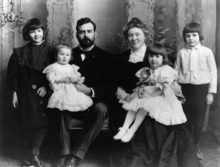
De Hemingway familie in 1905, van links naar rechts: Marcelline, Sunny, Clarence, Grace, Ursula en Ernest
Deze 1929 Rolls Royce Phantom II Short Coupled Saloon is van Ernest Hemingway geweest. Met deze auto doorkruiste hij de USA terwijl hij titels als ‘A Farewell to Arms’, ‘The Fifth Column and the First Forty-Nine Stories’ en ‘Death in the Afternoon’ schreef en uitgaf. De auto is voorzien van drank, golf en jacht opslag compartimenten.
Een andere auto van Ernest Hemingway is de Lancia B10 waarmee hij in 1954 door Europa reisde.
Ernest Hemingway, who famously wrote standing (“Hemingway stands when he writes. He stands in a pair of his oversized loafers on the worn skin of a lesser kudu—the typewriter and the reading board chest-high opposite him.”), approaches his craft with equal parts poeticism and pragmatism:
” When I am working on a book or a story I write every morning as soon after first light as possible. There is no one to disturb you and it is cool or cold and you come to your work and warm as you write. You read what you have written and, as you always stop when you know what is going to happen next, you go on from there. You write until you come to a place where you still have your juice and know what will happen next and you stop and try to live through until the next day when you hit it again. You have started at six in the morning, say, and may go on until noon or be through before that. When you stop you are as empty, and at the same time never empty but filling, as when you have made love to someone you love. Nothing can hurt you, nothing can happen, nothing means anything until the next day when you do it again. It is the wait until the next day that is hard to get through “.
In de winter van 1917 voerde het Rode Kruis campagne om Amerikaanse vrijwilligers te ronselen die op het Italiaanse front met ambulances wilden rijden. Hemingway ging daar op in, want in het Amerikaanse leger werd hij vanwege een slecht oog geweigerd voor de dienst. Op 8 juli 1918, pas enkele weken na zijn aankomst, werd hij aan zijn been gewond door granaatscherven, op het ogenblik dat hij chocolade en sigaretten aan Italiaanse soldaten langs de rivier de Piave uitdeelde. Volgens Ted Brumback, een andere ambulancechauffeur, die een brief schreef aan Hemingways vader, kreeg Hemingway meer dan 200 scherven in zijn benen, maar slaagde er ondanks deze verwonding toch in om een andere gewonde soldaat naar de Eerste Hulppost te brengen. Onderweg werd hij dan nog eens in zijn benen getroffen door verschillende machinegeweerkogels. Voor deze daad van zelfopoffering kreeg hij later de Italiaanse Zilveren Medaille voor Heldenmoed. De verwonding aan zijn rechterknie was zo ernstig dat hij vreesde dat het been zou moeten worden geamputeerd. Herstellend van zijn verwondingen in een ziekenhuis in Milaan, werd Hemingway verliefd op Agnes von Kurowsky, een goed opgeleide Amerikaanse verpleegster die acht jaar ouder was dan hij. Hemingway zou deze romance later in zijn roman A Farewell to Arms verwerken.
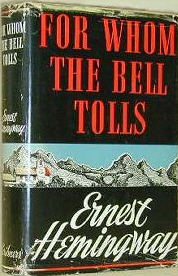
Ernest Hemingway schreef ‘For whom the bell tolls’, over zijn ervaringen in de Spaanse Burgeroorlog, in 1939 in Cuba, Key West en Sun Valley, Idaho
Het boek vertelt het verhaal van Robert Jordan, een jonge Amerikaanse explosievenexpert die als lid van de Internationale Brigades wordt toegevoegd aan een antifascistische guerrilla-eenheid in de bergen tijdens de Spaanse Burgeroorlog. Samen moeten zij een brug opblazen om een aanval op Segovia te doen slagen. Jordan wordt tijdens de missie verliefd op Maria, een meisje dat haar ouders heeft verloren door de oorlog.
Het boek bevat autobiografische gedeeltes, Hemingway was tijdens de burgeroorlog in Spanje. De hoofdpersoon is mogelijk gebaseerd op Robert Hale Merriman, een Amerikaan die in 1938 in Spanje was gesneuveld. Merriman was een kennis van Hemingway.
In WOII was Hemingway reporter in oorlogsgebieden in Europa en onderstaande tekst gaat over zijn ervaringen in België in die tijd:
On September 11th, 1944, Colonel Charles Trueman Buck Lanham, with a smouldering Lucky Strike permanently dangling from the left corner of his mouth, was looking through a splendid pair of captured German Zeiss field-glasses toward the river that formed the German border less than a hundred yards away.
“ Damn!”
“ What’s the problem, Buck?” asked Hemingway, who was playing a hand of gin rummy with Pelkey.
“ They’ve blown the damned the bridge. That was obviously the explosion we heard a minute ago.”
“ Who the hell are “they”, Buck?”
“ The damned SS. We heard yesterday that a few remnants of the 2nd SS Division might have been left behind to the give the regular German army a chance to get home to father.”
“ A joker don’t count, Archie. What can we do, Buck?”
“ Repair the bridge, I guess.”
Lanham then spotted one of his aides and yelled.
“ Captain!”
“ Sir?”
“ Get a bunch of engineers up here, and fast.”
“ Yes sir, but they’re way back…”
“ I didn’t ask where they were, captain, just get them up here.”
“ Yes, sir!”
The Captain roared off in his Jeep as Hemingway placed his cards on top of the low wall he and Pelkey were using as a card table.
“ Four, five, and six of clubs, oh, and eight, nine, ten, and jack of hearts. My hand I think, Archie? That’s a hundred dollars you owe me.”
“ Shit.”
Hemingway, Pelkey, and their little band, plus Lanham and a forward reconnaissance unit of his 22nd, were in the Belgian town of Houffalize – to the south of Liege, and just north of Bastogne – deep in the valley of the River Ourthe, beneath steep grey granite cliffs, which was, in the words of British historian Charles Whiting, “…the centre of a small road network and a bottle-neck. In three months time it was to be the centre of the great link up between the 1st and 3rd US Armies during the Battle of the Bulge and then it would be wrecked completely.”
For Lanham the bridge across the Ourthe, in the middle of the town, was essential for the eastward progress of the 22nd. But that didn’t bother the inhabitants of the town, who – even though many of their houses had been destroyed as the bridge went up – still heaped gifts of cakes,
eggs, and bottles of wine, upon Hemingway and the rest of the “liberators.”
“ Say, Ernie, if this were Oak Park, and your dear Mother was being liberated, would she offer cakes and wine?” asked Lanham.
“ I don’t ever remember seeing cakes in the house, sure as hell don’t recall eating any. And as for wine Buck, no chance, the Devil’s liqueur. No, any liberating army outside the Bitch’s house would be told in no uncertain terms to please stay off the grass and to be as quiet as possible so as not to disturb her afternoon nap. But then, who’d want to liberate Oak Park?”
After frying and devouring the eggs, eating the cakes, and drinking the wine, Lanham got the now assembled bunch of 22nd Infantry Engineers (the captain had found them brewing coffee less than three miles down the road) to gather together as many villagers as they could to start rebuilding the bridge with anything they could lay their hands on.
“ Wish I could get my hands on a Bailey Bridge, Ernie, but the damned Limeys keep them all to themselves, and the few the US have are in Holland.”
“ To hell with the Limeys, Buck.”
“ Yeh, but I still wish I had one of their damned bridges.”
Donald Bailey (later, Sir Donald) a pretty low grade British civil servant – and something of a Meccano fanatic as a boy – invented his so called Bailey Bridge in 1941, and eventually convinced the British military to take up his idea; and like all simple ideas it proved itself to be indispensable.
In essence a Bailey Bridge is a prefabricated metal road bridge that floats on pontoons, with the roadway element made-up of heavy duty timber planks. It can be assembled relatively easily, taking
around six hours to span a river the size of the Thames. The first was erected (under heavy enemy fire) in May 1944, at the battle of Monte Casino in Italy. Hundreds were used in the hours, days, and weeks after D-Day, enabling the Allied armies – especially the heavy armour and supply trucks – to maintain their necessary momentum whenever they came across a destroyed bridge. The Americans soon saw the usefulness of the invention and built hundreds under licence for their own use. As Colonel Lanham mentioned, by September of 1944 virtually all of the Bailey Bridges were being used in Holland as the Allied armoured divisions dashed toward Arnhem to relieve the besieged units of the British Airborne. To get an idea of how a Bailey Bridge was constructed, watch Sir Richard Attenborough’s superb 1977 film, A Bridge Too Far, and enjoy Elliott Gould’s wonderful portrayal of an unconventional, Colonel Lanham style, cigar-chewing American officer kicking ass. Of course Lanham had no chance of getting his hands on a Bailey Bridge, having to make do and mend. Bailey Bridges are still manufactured today.
Hemingway chose not to help re-build the bridge, but instead sat on a fence watching, drinking, and shouting orders on bridge-building techniques. Many of the town’s inhabitants, who genuinely thought Hemingway was in charge, immediately started referring to him as the General. Hemingway told them he was not a general, only a captain, and after being quizzed as to why he held such a lowly rank replied in deliberately broken French:
“Can’t read nor write is why. Never quite got around to it, but hell that don’t hold anyone back in the good old US Army.”
Ernest Hemingway was, as ever, enjoying himself hugely, and Lanham never told the Houffalizeans who was really in charge; why confuse them when they were building such an excellent bridge?
In fact it took less than an hour for the good people of Houffalize to rejoin the two halves of the bridge, and by early evening Lanham’s vehicles were crossing over in numbers – including tanks – to the German side and the inevitable confrontation.
A little further down river – where the Ourthe becomes the Sure – at the village of Stolzemburg, on the Luxembourg side of the river, which forms the border between Belgium, Luxembourg, and Germany, a young American Staff Sergeant, Warner H. Holzinger of the US 5th Armoured Division, took a patrol across the river – the bridge there had also been blown by the retreating Germans – and, avoiding the road, scaled the cliffs on the German side. They were the first allied soldiers to enter Germany in wartime since Napoleon’s invasion 150 years before. When they reached a small plateau fifty feet from the top of the cliffs they came across several empty camouflaged bunkers which were being used as a chicken coops by a farmer.
“ Well, if this is the famous West Wall, I don’t think much to it,” Holzinger said to a corporal at his side.
But when his patrol finally reached the cliff top and looked downward toward the heart of Germany they saw hundreds of pillboxes and bunkers of every shape and size. They hit the dirt expecting a barrage of fire, but nothing happened, not a single shot came their way. With night coming on Holzinger didn’t feel like hanging around and ordered his patrol back down the cliff and across the river. He had no desire to see if those other bunkers were empty or not.
When the sergeants report reached General Courtney Hodges, Commander of the US 1st Army, the General issued the following statement:
“ At 1805 hrs on 11th September, a patrol led by Sgt Warner H. Holzinger crossed into Germany near the village of Stolzemburg, a few miles north-east of Vianden, Luxembourg.”
As Warner and his patrol celebrated with a few drinks, and Colonel Clarence Park, Patton’s Inspector General, began to assemble and co-ordinate the paperwork for the interrogation of Ernest Hemingway, the novelist himself went to bed early, after a good dinner, and dreamed of
hunting deer in the forests around Lake Michigan, countryside that was not unlike that around Houffalize.
The morning of Tuesday the 12th September 1944 was clear and sunny, and as Hemingway awoke slowly from a dream where he was hunting deer with his son Patrick in Idaho, and had this most wonderful young stag clear in his sights, and was about to squeeze the trigger and put a .45 shell
cleanly into the back of the animal’s brain, the deer turned his head and looked at Hemingway, and his dark doleful eyes and trusting soft eared head turned into the anguished depressed face of Hemingway’s dead father. Ernest squeezed the trigger anyway.
Hemingway was awake now and looking up from his bed at his ageing face in the cracked oval mirror that hung above the large pine dressing table that stood against the wall in front of the bed of the first floor bedroom of the hunting lodge he, Pelkey, and the others were sharing. Hemingway then looked at his watch, six am, and not a sound except some distant snoring, and the sound of a million animals and birds stretching their wings and limbs amongst the trees and undergrowth
of this part of the dense Ardennes Forest. Funny, Hemingway thought, how, in the midst of war, nature continued to do what nature does, which is preen and sing, and scratch, and burrow, and eat, and fornicate and kill, and be killed. Not so different really to what the rest of the world was doing on this beautiful September morning.
Ernest Hemingway wanted to get up but decided against it for the minute and luxuriated a little longer in the warmth and softness of the feather mattress and fell asleep again, and dreamed, and dreamed of seeing James Joyce…
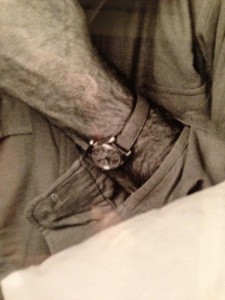
De foto van de Bubbleback is gemaakt in de kleedkamer in Ralph Lauren op Worth Avenue in Palm Beach, Florida.
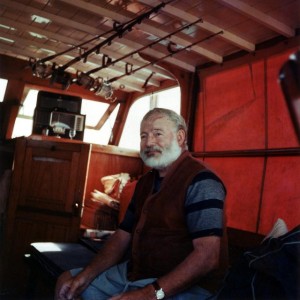
Ernest Hemingway in de kajuit van zijn boot ‘El Pilar’. Om zijn pols waarschijnlijk een 18k gouden Rolex Oyster met leren band uit de 1950s
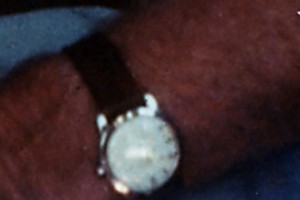
Navraag over de details van de Rolex horloges van Hemingway bij de John F. Kennedy Presidential Library in Boston leverde helaas niet de gewenste resultaten op. In hun Ernest Hemingway archief werd geen enkele Rolex aangetroffen. De enige drie horloges die bij hun vermeld staan zijn de volgende:
1. Jewelry. Pocket Watch. Gold, metal, glass. Gold pocket watch with second hand dial. Glass face plate is broken. MO 2002.29
2.Jewelry. Pocket Watch. Silver. Silver pocket watch with viello on reverse and “Willoughby A. Hemingway, Dec. 25, 02” inscribed on interior backing. Face plate is missing. MO 2002.29.3
3. Jewelry. Watch. Metal, plastic. 1 ½ in. Swiss wrist watch with plastic cover. Wrist strap is missing. MO 2002.23.2
Een ander interessant horloge van Hemingway, ook geen Rolex, is het Hamilton zakhorloge uit 1906 dat hij in 1954 van de actrice Ava Gardner voor zijn 55ste verjaardag kreeg. Onderstaand artikel vertelt het hele verhaal:
Hemingway “Birthday” Pocket Watch
In 1951 schreef Hemingway in Cuba een van zijn bekendste werken, ‘The Old Man and the Sea’. Uitgegeven in 1952 was het het laatste belangrijke fictieve werk van Hemingway dat nog tijdens zijn leven werd uitgegeven. Het verhaal gaat over Santiago, een oude visserman, die 84 dagen lang niets gevangen heeft. Zijn leerling Manolin mag van zijn ouders niet meer met Santiago mee, hij moet op pad met meer succesvolle vissers, maar de jongen blijft nog wel voor de oude man zorgen. ‘s Avonds brengt hij Santiago voedsel en hebben ze het eindeloos over de fameuze Amerikaanse honkbalspeler Joe DiMaggio.
Die avond vertelt Santiago dat hij de volgende dag in zijn eentje helemaal naar de Gulf Stream, ten noorden van Cuba in de Straits of Florida, zal varen en dat zijn ‘salao’ (de ergste vorm van pech) voorbij zal zijn. Op dag 85 rond het middaguur heeft Santiago beet, een grote vis waarvan hij overtuigd is dat het een marlijn is.
Er ontvouwt zich een strijd die drie dagen zal duren en als de vis eindelijk aan zijn sloep is bevestigd is Santiago volledig uitgeput en bijna delirant. Terwijl hij aan het rekenen is hoeveel deze marlijn hem wel niet gaat opbrengen, verschijnen de eerste haaien die afgekomen zijn op het bloedspoor achter de boot. Santiago slaagt erin de eerste vijf haaien van zich af te slaan maar ze blijven maar komen. Uiteindelijk komt hij terug in de haven met slechts het reusachtig skelet van de vis. Als een ongeruste Manolin die avond bij hem langskomt ligt Santiago te slapen en droomt hij over zijn jeugd, leeuwen op een Afrikaans strand.
In 1953 kreeg ‘The Old Man and the Sea’ de Pulitzer Price for Fiction en het boek speelde een belangrijke rol in het krijgen van de Nobelprijs voor Literatuur die Ernest Hemingway in 1954 in ontvangst mocht nemen.
Ernest Hemingway geportretteerd door de fotograaf Yousuf Karsh in 1957. Om zijn pols draagt hij een stalen Rolex Oyster Perpetual uit de 1950s. De begeleidende tekst bij de foto:
‘He did not like to talk about his work. Once he had written a book, he said, it went out of his mind completely and no longer interested him. “I must forget what I have written in the past, before I can project myself into a new work.”
What did he think, I asked, about the large tribe of writers who imitate his style? The trouble with imitators, he said, was that they were able to pick out only the obvious faults in his work; they invariably missed his real purpose’.
Het commentaar van Karsh bij de foto:
‘I expected to meet in the author a composite of the heroes of his novels. Instead, in 1957, at his home Finca Vigía, near Havana, I found a man of peculiar gentleness, the shyest man I ever photographed – a man cruelly battered by life, but seemingly invincible. He was still suffering from the effects of a plane accident that occurred during his fourth safari to Africa. I had gone the evening before to La Floridita, Hemingway’s favourite bar, to do my “homework” and sample his favorite concoction, the daiquiri. But one can be overprepared! When, at nine the next morning, Hemingway called from the kitchen, “What will you have to drink?” my reply was, I thought, letter-perfect: “Daiquiri, sir.” “Good God, Karsh,” Hemingway remonstrated, “at this hour of the day!”’.
In het boek met de titel ‘Across the river and Into the Trees’ (1950) schrijft Hemingway het volgende over een Rolex Oyster (blz 117-118):
‘ “It’s just a muscle,” the Colonel said. “Only it is the main muscle. It works as perfectly as a Rolex Oyster Perpetual. The trouble is you cannot send it to the Rolex representative when it goes wrong. When it stops, you just do not know the time. You’re dead.”‘.
Jaap Bakker
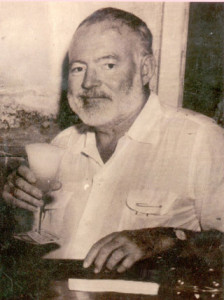
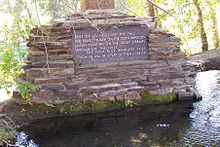
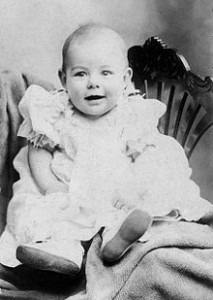
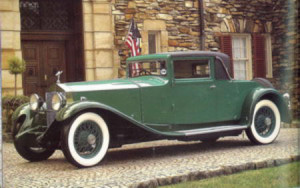
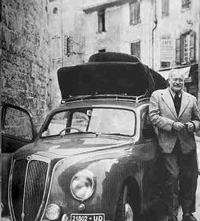
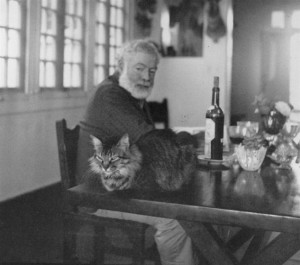
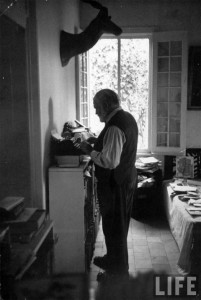
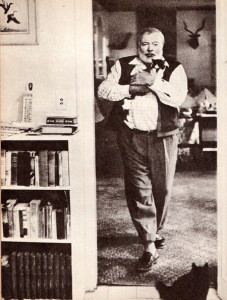
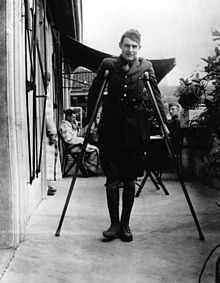
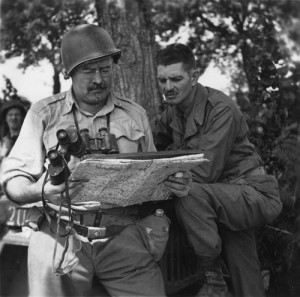
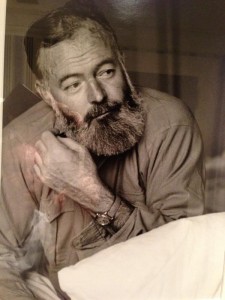
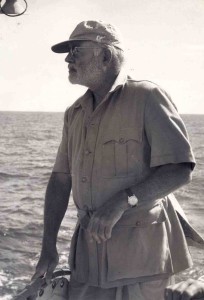
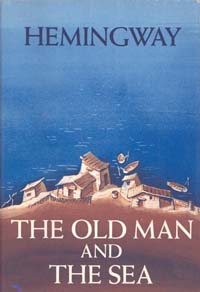
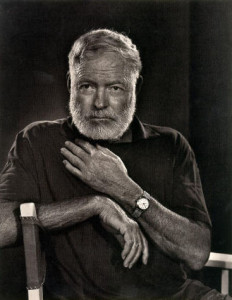
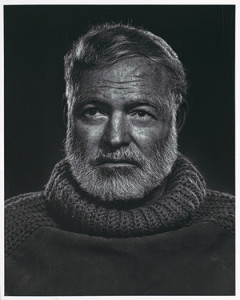
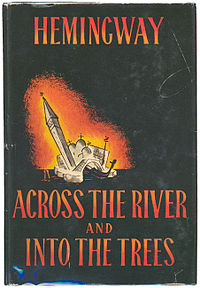
Geef een reactie